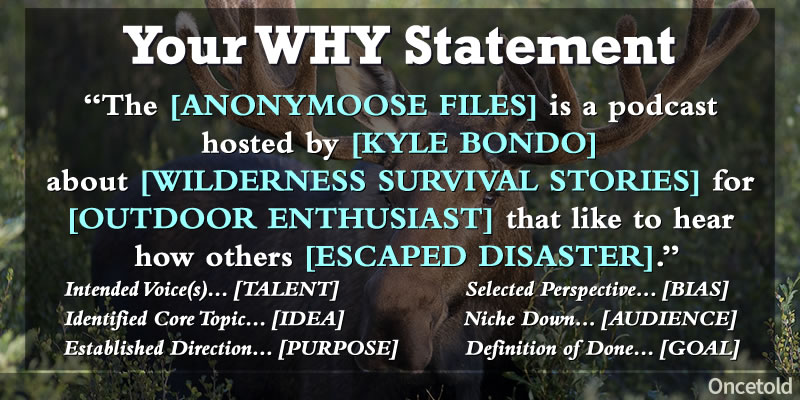
Crafting Your Why Statement
Why, Oh, Why Have a Why Statement?
Your Why Statement is your podcast's mission statement.
If your purpose is an intrinsic expression of why YOU are doing this, then your Why Statement is an extrinsic expression of why your target audience should listen to it.
It is a way of taking everything you've decided on, up with this point -- your idea (What will I talk about), your purpose (Why am I doing this), and your target audience (Who is this for) -- and distilling it down into a single, crispy sentence.
The best part of a Why Statement is a daily reminder of the promise you are making to your target audience. It is the service level agreement you make with your listeners that tells them what they should expect to hear every episode when they press play.
The reason you do this is to declare -- to YOURSELF -- who this podcast is for and why that audience should listen to it.
Externally, you share your Why Statement as the description of your podcast.
But internally, you need to look at it every day, every time you step up to the microphone, and most importantly, every time you plan an episode.
Building a Why Statement
Every Why Statement begins by answering these five questions:
- What will I talk about - Idea/Topic
- Why am I doing this - Purpose/Direction (Lesson 3)
- Who is this for - Perspective/Bias/Target Audience (Lesson 4)
- Who will be the talent - Talent/Host/Voices
- When will it be done - Goal/Ending
These are not trick questions. Instead, they are meant to be thought-provoking in a way that gets you to take your podcast's production seriously.
Let's take this question one at a time.
What will I talk about?
Well? What are you going to talk about? What is your core idea or topic you will focus on?
Why am I doing this?
I walked you through making meaning in Lesson 03 which hopefully helped you decide on your purpose for this podcast.
If you have not decided on your purpose, I recommend you go back to Lesson 03 and take another try at establishing one.
Who is this for?
I walked you through picking a side and deciding on your target audience in Lesson 04.
If your target audience is still a mystery to you, I recommend you go back to Lesson 04 and try to define that niche one more time.
Who will be the talent?
This should be an easy question to answer. Either you are the host or you are not. If you are not the host, who is?
Or if you are going to be a co-host then who else will co-hosting with you?
Solve for X.
When will it be done?
This is a question defining your definition of done. It may seem easy but it can be a tricky one.
This is a question defining your definition of done. It may seem easy but it can be a tricky one. All podcasters want their podcast to last forever. Sadly, it will not. It may go on for many, many years but at some point, it will end.
However, your definition of done does not need to be a date but rather a part of the statement that defines the totality of your work. This could mean until I talk to everyone there is to talk to, until the case is solved, or until I reach the end of the battle.
Or it could simply be until I decide it's done.
The point of the question is to force you to consider what done would mean to you. It's your podcast. You decide if there is an ending or goal.
One Sentence, Please
All the work up to this point has been to establish a clear, concise, and crispy understanding of your podcast's details.
Now that you understand the principle behind the reason for a Why Statement, it is time to create your own one-sentence Why Statement by simply filling in the blanks:
The [PODCAST NAME] is a podcast hosted by [TALENT NAME] about [IDEA/TOPIC] for [TARGET AUDIENCE] who like to hear about [NICHE/BIAS/PERSPECTIVE] until [GOAL].
Is that it? Yes! That's it! But look how far you've come to get this one sentence in place.
Is a Why Statement set in stone? No! You can change any of the words, leave off the "until [GOAL]", change hosted to co-hosted -- it's your show!
Once you've finished crafting your Why Statement to your own satisfaction, remember it. Recite it every time you sit down to record your podcast. Place it on a sticky note on your wall and read it every day.
This is your podcast's map -- don't lose it!
Now What?
The point of all these lessons up to now was to have you think through your podcast design BEFORE you started planning episodes.
In the next lessons, you will find that your answers to these important questions will make or break how you plan your episodes.






